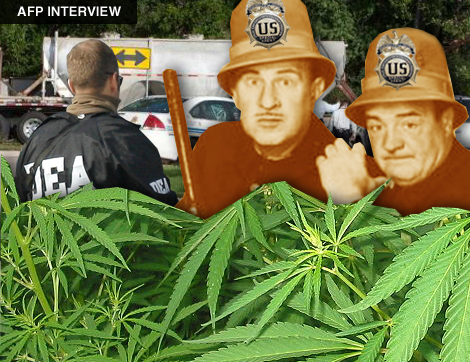
• DEA sued by business owner after feds use his truck to transport load of ‘pot’
By Pat Shannan
The owner of a north Texas trucking company is demanding compensation from the Drug Enforcement Administration (DEA), saying federal agents had concocted an elaborate scheme whereby one of their drug informants got a job at the company and used a company truck in drug runs. Eventually, the employee was killed and the truck sustained massive damage during a shootout when one of the DEA’s drug runs went bad.
The owner of the company, Craig Patty, 50, told AMERICAN FREE PRESS in an exclusive interview that he had hired Lawrence Chapa as a driver five weeks earlier and had no knowledge of his side job assisting the DEA.
Just how and when Chapa became a federal drug runner and informant is a mystery to all except the DEA, and its officials are not talking. Last November Chapa was shot eight times as he sat in the truck cab in front of a dozen or more law enforcement officers, who were in the act of setting up a sting operation. The officers said they were caught by surprise when members of a Mexican drug cartel attacked and allegedly attempted to hijack the truck and its load of 70 tons of marijuana. In the confusing melee, because the officers were from various agencies and did not know one another, a Houston police officer shot and seriously wounded a Harris County sheriff’s deputy.
The four “hijackers”—three born in Mexico—were captured and charged with murder, but because of the eight-shot overkill, the question looms whether Chapa’s cover had been blown and if he might have actually been set up for murder with the “hijacking” as a ruse and convenient cover story. The ballistic evidence attests to this.
The bullet holes in the doors, windows and Chapa’s body were made by low caliber weapons fired from handguns by the attackers on the street, but a fourth shooter, who was not arrested until two days later, was firing a high-powered rifle in front of the truck from a secluded position some distance away. Bullet holes in the front of the truck indicated that the more powerful rifle shots were apparently intended to disable the truck.
“Not exactly a wise tactic, if they were planning to drive it away the next minute,” noted one astute observer.
On July 23, Patty officially informed the DEA of his plans to sue the agency if it would not cover his losses. He is asking for $133,532 in repairs and lost earnings for the 100 days his truck was out of commission, as well as $1.3 million in punitive damages. Patty lives in constant fear of retaliation from the drug cartel, who may falsely believe he was part of the sting. His family is constantly armed, including around the house.
Ironically, Patty’s insurance company has denied his insurance claim because the truck was used by the federal government in a law enforcement operation. His company is a small business that hauls sand as part of hydraulic fracturing operations for oil and gas companies. He had only one other truck in operation, which means his business was literally cut in half and pushed to the brink of bankruptcy after the attack in Houston.
While Chapa had led Patty to believe the truck was in a repair shop, he was actually traveling over 1,000 miles to the Rio Grande Valley in south Texas, only days before the shooting. GPS information from the truck disclosed the destination of the trip, but only after the credit card bills came in the next month did Patty realize that he, instead of the DEA, also had funded the gasoline expenses for the marijuana run to the border.
The Houston Chronicle reported that comments made by prosecutors later in court confirmed that the agency had been paying Chapa for undercover work. However, Patty does not know if the arrangement existed prior to his hiring of his new driver. Chapa had been arrested more than a year earlier for possession and may have cut a deal to become an informant at that time.
“I was not part of this,” Patty told this AFP writer. He went on to explain that his first knowledge of it came with an early morning phone call that woke him with the information some 17 hours after it happened.
Independent investigation after the fact uncovered another part to the puzzle that does not bode well for the DEA. Four days prior to the street shooting of Chapa, a man was stopped by police in a neighborhood where they were watching a suspected drug house. Eric de Luna, 23, had no incriminating contraband in his car but was carrying $5,600 in cash on his person. When officers asked where he had gotten it, he explained that he was a house painter and had been paid in cash for a recent job.
The cops made a couple of phone calls, confiscated the $5,600 as suspected drug-purchase money, but made no arrest. Four days later de Luna was arrested for murder as one of the “three” shooters who allegedly killed Chapa.
Pat Shannan is an AFP contributing editor and the author of several best-selling videos and books.

